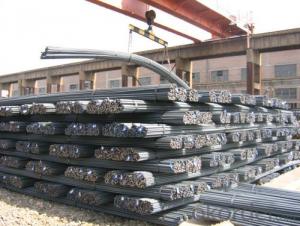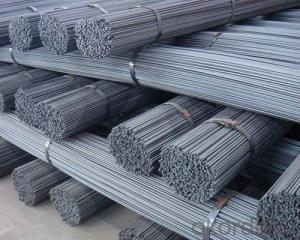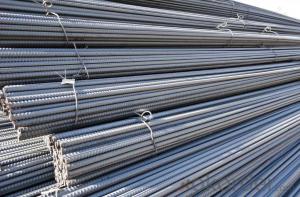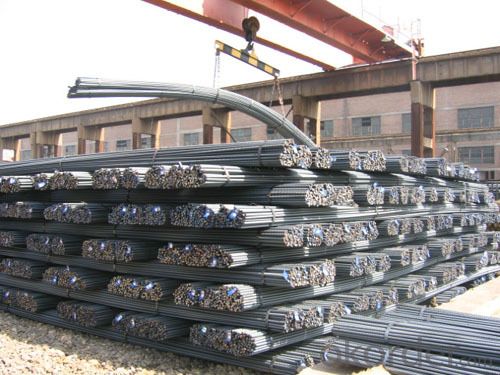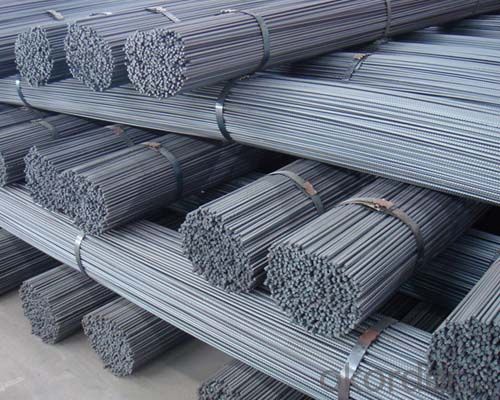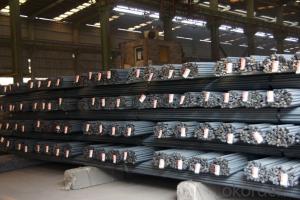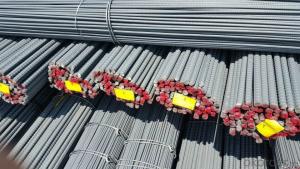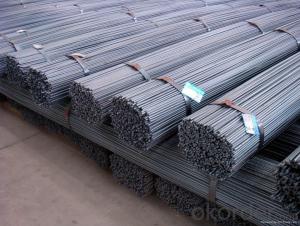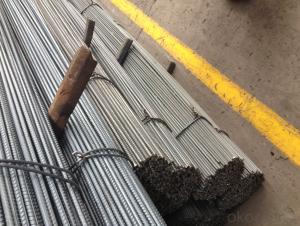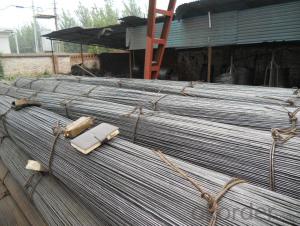Deformed bars in Grade HRB400/500 with Best Quality
- Loading Port:
- Tianjin
- Payment Terms:
- TT OR LC
- Min Order Qty:
- 25 m.t.
- Supply Capability:
- 100000 m.t./month
OKorder Service Pledge
OKorder Financial Service
You Might Also Like
Product Description:
Specifications of HRB400 Deformed Steel Bar:
Standard | GB | HRB400 | |
Diameter | 6mm,8mm,10mm,12mm,14mm,16mm,18mm,20mm, 22mm,25mm,28mm,32mm,36mm,40mm,50mm | ||
Length | 6M, 9M,12M or as required | ||
Place of origin | Hebei, China mainland | ||
Advantages | exact size, regular package, chemical and mechanical properties are stable. | ||
Type | Hot rolled deformed steel bar | ||
Brand name | DRAGON | ||
Chemical Composition: (Please kindly find our chemistry of our material based on HRB500 as below for your information)
Grade | Technical data of the original chemical composition (%) | ||||||
C | Mn | Si | S | P | V | ||
HRB400 | ≤0.25 | ≤1.60 | ≤0.80 | ≤0.045 | ≤0.045 | 0.04-0.12 | |
Physical capability | |||||||
Yield Strength (N/cm²) | Tensile Strength (N/cm²) | Elongation (%) | |||||
≥400 | ≥570 | ≥14 | |||||
Theoretical weight and section area of each diameter as below for your information:
Diameter(mm) | Section area (mm²) | Mass(kg/m) | Weight of 12m bar(kg) |
6 | 28.27 | 0.222 | 2.664 |
8 | 50.27 | 0.395 | 4.74 |
10 | 78.54 | 0.617 | 7.404 |
12 | 113.1 | 0.888 | 10.656 |
14 | 153.9 | 1.21 | 14.52 |
16 | 201.1 | 1.58 | 18.96 |
18 | 254.5 | 2.00 | 24 |
20 | 314.2 | 2.47 | 29.64 |
22 | 380.1 | 2.98 | 35.76 |
25 | 490.9 | 3.85 | 46.2 |
28 | 615.8 | 4.83 | 57.96 |
32 | 804.2 | 6.31 | 75.72 |
36 | 1018 | 7.99 | 98.88 |
40 | 1257 | 9.87 | 118.44 |
50 | 1964 | 15.42 | 185.04 |
Usage and Applications of HRB400 Deformed Steel Bar:
Deformed bar is widely used in buildings, bridges, roads and other engineering construction. Big to highways, railways, bridges, culverts, tunnels, public facilities such as flood control, dam, small to housing construction, beam, column, wall and the foundation of the plate, deformed bar is an integral structure material. With the development of world economy and the vigorous development of infrastructure construction, real estate, the demand for deformed bar will be larger and larger..
Packaging & Delivery of HRB400 Deformed Steel Bar:
Packaging Detail: products are packed in bundle and then shipped by container or bulk vessel, deformed bar is usually naked strapping delivery, when storing, please pay attention to moisture proof. The performance of rust will produce adverse effect.
Each bundle weight: 2-3MT, or as required
Payment term: TT or L/C
Delivery Detail: within 45 days after received advanced payment or LC.
Label: to be specified by customer, generally, each bundle has 1-2 labels
Trade terms: FOB, CFR, CIF
- Q: Are there any safety precautions when handling steel rebars?
- Yes, there are several safety precautions that should be followed when handling steel rebars. Firstly, it is important to wear appropriate personal protective equipment (PPE) such as gloves, safety glasses, and steel-toed boots to protect against potential injuries. Secondly, rebars should be lifted and carried in a manner that avoids strain on the back and muscles, using proper lifting techniques. Additionally, workers should be cautious of sharp edges and ensure that the rebars are stacked or stored securely to prevent them from falling or rolling. Regular inspection of rebars for any defects or damage is also essential for safety.
- Q: What is the role of steel rebars in earthquake-resistant building design?
- Steel rebars play a crucial role in earthquake-resistant building design by providing reinforcement and strength to concrete structures. They help distribute and absorb the energy generated during an earthquake, preventing the structure from collapsing or sustaining severe damage. The rebars increase the tensile strength of the concrete, enhancing its ability to withstand the lateral forces and ground shaking caused by an earthquake.
- Q: What are the different types of steel rebars available for different applications?
- For various applications, there is a wide range of steel rebars available. Some of the commonly used types are as follows: 1. Mild Steel Rebars: These rebars are frequently utilized in construction projects and have a low carbon content, making them cost-effective. They are suitable for general construction purposes and find application in residential buildings, bridges, and small to medium-sized structures. 2. High-strength Reinforcement Bars (HSRB): These rebars possess a higher tensile strength compared to mild steel rebars. They are commonly employed in high-rise buildings, large infrastructure projects, and heavy-duty structures that require greater strength. HSRB rebars are often manufactured using alloys like carbon, manganese, or silicon to enhance their strength. 3. Epoxy-Coated Rebars: To protect against corrosion, these rebars are coated with epoxy resin. Epoxy-coated rebars are commonly used in marine structures, parking garages, and areas with high humidity or exposure to moisture. The epoxy coating acts as a barrier, preventing the steel from coming into contact with corrosive elements, thereby extending the rebar's lifespan. 4. Stainless Steel Rebars: In contrast to mild steel rebars, stainless steel rebars contain a substantial amount of chromium, providing excellent resistance to corrosion. These rebars are often employed in highly corrosive environments such as coastal areas, chemical plants, and wastewater treatment facilities. Stainless steel rebars are also preferred in structures that require high aesthetic appeal, such as architectural buildings and monuments. 5. Galvanized Rebars: Zinc coating is applied to galvanized rebars to safeguard them against corrosion. The zinc coating acts as a sacrificial layer, corroding itself before the underlying steel is affected. These rebars are commonly used in areas with moderate corrosion risks, such as concrete structures exposed to deicing salts or in coastal regions. 6. Carbon Fiber Reinforced Polymer (CFRP) Rebars: CFRP rebars consist of carbon fibers embedded in a polymer matrix. They are lightweight, corrosion-resistant, and possess high tensile strength. CFRP rebars are frequently used in retrofitting existing structures, as they provide excellent strength and durability without adding significant weight. The selection of the appropriate steel rebar depends on the specific application, environmental conditions, and structural requirements. It is crucial to consult structural engineers and adhere to local building codes and standards to ensure the correct type of rebar is chosen for each project.
- Q: How do steel rebars affect the thermal properties of a structure?
- The thermal properties of a building or structure can be significantly influenced by steel rebars, which are commonly used in reinforced concrete structures. To begin with, steel rebars have a higher thermal conductivity than concrete. This means that when embedded within concrete, they can serve as thermal bridges, allowing heat to easily transfer through the structure. Consequently, there is increased heat loss during colder months and increased heat gain during warmer months, leading to higher energy consumption for heating and cooling. Additionally, the thermal expansion and contraction of the structure can be affected by steel rebars. Compared to concrete, steel has a higher coefficient of thermal expansion, causing it to expand and contract more with temperature changes. This differential movement between the steel rebars and the surrounding concrete can result in cracks and structural deformations, compromising the overall thermal performance of the structure. Moreover, the moisture behavior of a structure can also be influenced by steel rebars. As previously mentioned, steel has a higher thermal conductivity and electrical conductivity than concrete. This electrical conductivity can promote the corrosion of steel rebars when they come into contact with moisture or water. Consequently, corrosion leads to the formation of rust, which expands and further damages the surrounding concrete. This, in turn, increases moisture ingress, compromising the insulation properties of the structure and potentially causing mold growth and other moisture-related issues. To conclude, steel rebars have direct and indirect impacts on the thermal properties of a structure. They act as thermal bridges, affecting heat transfer, and their differential thermal expansion and corrosion potential can compromise the overall thermal performance and moisture behavior of the structure. Proper design, insulation, and corrosion protection measures should be implemented to mitigate these effects and ensure optimal thermal performance.
- Q: What are the common applications of steel rebars in construction?
- Steel rebars are commonly used in construction for reinforcement purposes. They are primarily used in reinforced concrete structures such as foundations, beams, columns, and slabs to enhance their structural integrity and strength. Rebars help to resist tension forces, prevent cracking, and improve the overall durability of the concrete.
- Q: How are steel rebars connected to each other?
- Steel rebars are typically connected to each other using various methods such as overlapping, welding, or using mechanical connectors like couplers or threaded bars.
- Q: How do steel rebars affect the overall strength of a structure?
- Steel rebars significantly enhance the overall strength of a structure by providing reinforcement and increasing its tensile strength. They act as a skeleton within the concrete, distributing the load more evenly and preventing cracks or failures.
- Q: How do steel rebars affect the overall creep and shrinkage of concrete structures?
- The overall deformation of concrete structures can be significantly affected by steel rebars. Creep, which refers to the long-term deformation of concrete under sustained load, and shrinkage, the reduction in volume during drying and hardening, are both influenced by rebars. To control and mitigate both creep and shrinkage, steel rebars play a crucial role. When embedded in concrete, rebars enhance the load-carrying capacity and provide tensile strength to the structure. This reinforcement allows for stress distribution and limits deformation over time. In terms of creep, steel rebars minimize its effects by reducing stress transferred to the concrete. By absorbing a significant portion of the load applied, rebars alleviate strain and reduce creep deformation. Furthermore, rebars help control cracking caused by creep, thus preserving the concrete's structural integrity. Regarding shrinkage, steel rebars also impact its magnitude. As concrete shrinks during drying and hardening, rebars act as restraints, preventing excessive volume reduction. By resisting contraction forces, rebars minimize the potential for cracking and maintain the concrete's structural stability. It is important to consider the type, size, and spacing of rebars as they can affect the overall impact on creep and shrinkage. Proper design and placement, including appropriate cover thickness, are necessary to ensure optimal performance and minimize long-term deformations. In conclusion, steel rebars play a vital role in controlling creep and shrinkage in concrete structures. By providing reinforcement, distributing stress, and preventing cracking, rebars maintain the structural integrity of concrete over time.
- Q: Can steel rebars be used in foundation construction?
- Yes, steel rebars can be used in foundation construction. They are commonly used as reinforcement to provide strength and stability to concrete foundations, ensuring durability and resistance to structural loads.
- Q: Can steel rebars be bent without compromising their strength?
- Steel rebars possess the ability to be bent while still maintaining their strength. Their high tensile strength enables them to endure the forces of bending and stretching without experiencing any breakage or loss of structural integrity. The process of bending involves the application of a regulated amount of force to the rebar, causing the material to deform and acquire a new shape. However, it is essential to adhere to the recommended limits and guidelines provided by the manufacturer or industry standards when carrying out the bending procedure. Exceeding the specified limits may result in the development of microcracks or other defects that can compromise the strength of the rebar. Therefore, it is of utmost importance to employ proper bending techniques and utilize suitable equipment to ensure that the steel rebars retain their strength even after being bent.
Send your message to us
Deformed bars in Grade HRB400/500 with Best Quality
- Loading Port:
- Tianjin
- Payment Terms:
- TT OR LC
- Min Order Qty:
- 25 m.t.
- Supply Capability:
- 100000 m.t./month
OKorder Service Pledge
OKorder Financial Service
Similar products
Hot products
Hot Searches
Related keywords
